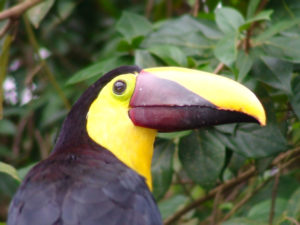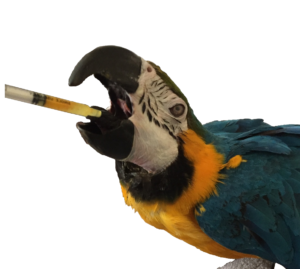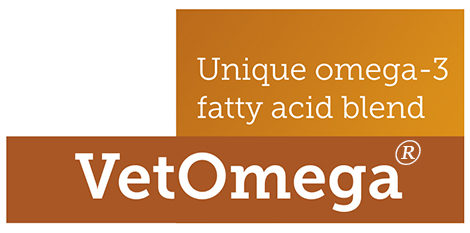VetOmega® Background and Dosing

VetOmega® was designed by scientists with an emphasis on providing readily available omega-series fatty acids that can be added to food or taken as a stand alone supplement.  The veterinary community has been using VetOmega® for nearly 2 decades- and now we are making it available to the public.
VetOmega® is a plant-based omega 3, 6 and 9 fatty acid supplement that is used as a dietary supplement for herbivorous and omnivorous animals. It is primarily a blend of flax and other plant based oils along with specifically designed antioxidants made to pharmaceutical, non-GMO and certified organic standards. As a part of the high standards, VetOmega® has been tested and verified for proper ingredients, ingredient ratios and lack of contaminants and toxins by a third party lab testing company.  Additionally, Quality Assurance International has certified VetOmega® as organic. VetOmega® is considered a ‘high omega-3 supplement’ due to its 3:1 omega-3:omega-6 ratio.
VetOmega® dosing and storage instructions: Dosage rate 0.22-0.44 cc/Kg orally (or with food) once daily. Do NOT shake the bottle. This damages the omega-3 fatty acids. Keep Refrigerated. It is best to discard and replace the bottle 3 months after opening.
When to Use VetOmega®
Suggested Uses for VetOmega® for the Exotic Animal Patient Include Support of the Following Body Systems

- Heart and vascular health- supplemental omega-3’s have been shown to reduce risk of atherosclerosis and decrease arrythmias in several animal models.
- Bone health- supplemental omega3’s have been shown to improve bone mineral density, especially when combined with exercise.
- Joint health- supplemental omega-3’s have been studied to help slow joint degradation and/or be used as adjunctive therapy for arthritis.
- Cancer- supplemental omega-3’s have been shown to either reduce incidence of, or slow progression of selected cancers in chickens, rats, and more.
- Kidney health- supplemental omega-3’s have been a cornerstone therapy in managing kidney diseases in multiple species.
- Obesity- supplemental omega-3’s have been shown to reduce harmful fat deposition in overweight animals.
**See ‘Scientific Research…‘ below for supporting studies.
VetOmega® may be used with nutraceutical products to formulate specific mixes to support cardiac, liver, skin, kidney, bone, joint and immune function. Our team has extensive experience using VetOmega® with pharmaceutical grade glucosamine, Coenzyme Q10, silymarin and other neutraceutical products.  More information about nutraceuticals mixtures can be obtained by contacting us directly.
VetOmega® is appropriate for the following taxa and species:
Birds: We reccommend VetOmega® for any species of parrot, chicken, dove, pigeon, and pet ducks. VetOmega is also appropriate for omnivorous passerines such as finches and other songbirds.
Reptiles: VetOmega® may be used for omnivorous species such as bearded dragons, tortoises, box turtles, and iguanas.
Small Mammals: We recommend VetOmega® for small mammal patients including ferrets, rabbits, chinchillas, guinea pigs, hamsters, gerbils, mice and rats.

Zoological Use
VetOmega® is currently being utilized in zoological institutions for collection animals to add additional dietary support for acute or chronic disease processes. Zoological species that may benefit from VetOmega® supplementation include any herbivorous or omnivorous avian, reptile, or small mammal species. VetOmega® may also be supplemented to insect diets that are being gut loaded and offered as food to carnivorous animals.
How to Buy VetOmega®
Purchasing VetOmega® for Your Pet

VetOmega® 1oz is available online through this website for it’s retail price of $31.95. There is a dosing chart available for your exotic pet below if you are purchasing online instead of directly through your veterinarian. Many patients have been trained to take VetOmega® voluntarily from the syringe or on a food item.
Purchasing VetOmega® for Professional Use
VetOmega® for the veterinary practice, professional aviaries and licensed rehabilitation/rescue centers comes in 2 sizes. If interested in becoming a professional distributor, please ‘Contact Us’.

About the Creator: M. Scott Echols, DVM, DABVP
VetOmega® is an Avian Studios, LLC product and was co-developed by Dr Scott Echols. Avian Studios, LLC was founded by M. Scott Echols, DVM, DABVP (Avian) in 2000. Dr. Echols is an avian board certified veterinary specialist and is known world wide for his lectures, writing, research and clinical surgery and medicine.
Scott lives with his wife, Layle (also a veterinarian), daughter Alaina, along with many animal companions while practicing in multiple locations in the United States. His diverse interests include avian medicine and surgery, art, making educational movies, playing guitar, outdoor activities, nutrition, and building sustainable positive benefit businesses.
Dr. Echols received the 2005 Ted Lafeber International Avian Practitioner of the Year award, the 2007 Texas Non-Traditional Species Veterinarian of the Year award, two 2017 Wellcome Images awards, the 2018 Distinguished Texas A&M Alumnus Award and he has had two original watercolor paintings (‘Two Collared Aracaris’ (pictured right) and ‘Archaeopteryx’) appear on the cover of the international Journal of Avian Medicine and Surgery. In 2017, Dr Echols was featured on NPR’s Science Friday in both video and audio formats and The Atlantic’s Quartz online publication.
Scott is an Adjunct Professor at Texas A&M College of Veterinary Medicine, a past President for the Association for Avian Veterinarians, a frequent lecturer at multiple universities and conferences in the US and abroad, as well as author and filmmaker.
After completing a bird medicine and surgery residency with Dr Brian Speer at the Medical Center for Birds in Oakley, California, Scott became the Director of Avian Medical and Surgical Services at Westgate Pet and Bird Hospital. Â Now, Dr. Echols lives with his family in Utah and works locally and worldwide. He most frequently works locally at Parrish Creek Veterinary Clinic in Centerville, Utah.
After graduating from his residency, Dr Echols added film to his efforts. Since then his film work has been centered on providing teaching videos to other veterinarians and bird owners. His focus on teaching foraging techniques to improve the lives of pet birds along with his short movie ‘Captive Foraging’ have gained him international attention.
Most recently, Scott and his mentor Brian Speer have developed a consultation and surgery business that provides veterinary bird care services throughout North America.  Dr. Echols is the director of the Grey Parrot Anatomy Project and also founded Scarlet Imaging which develops revolutionary contrast agents that are changing the scientific communities understanding of anatomy, disease and more in all animals including humans.
Scientific Research Supporting Use of Omega-Series Fatty Acids in Animals
Birds:
- Tarlton JF, Wilkins LJ, Toscano MJ, et al. Reduced bone breakage and increased bone strength in free range laying hens fed omega-3 polyunsaturated fatty acid supplemented diets. Bone. 2013; 52: 578–586.
- Liu D, et al. Long-term supplementation of various dietary lipids alters bone mineral content, mechanical properties and histologic characteristics of Japanese quail. Poult Sci. 82:831-839, 2003.
- Baird HT, Eggett DL, Fullmer S. Varying ratios of omega-6:omega-3 fatty acids on the pre- and postmortem bone mineral density, bone ash, and bone breaking strength of laying chickens. Poult Sci. 87:323-328, 2008.
- Liu, W.-m., Lai, S.-j., Lu, L.-z., Shi, F.-x. et al. (2011) Effects of dietary fatty acids on serum parameters, fatty acid compositions, and liver histology in Shaoxing laying ducks. Journal of Zhejiang University Science B (Biomed & Biotechnology), 12, 736–743.
- Schiavone, B.A., Romboli, I., Chiarini, R. and Marzoni, M. (2004) Influence of dietary lipid source and strain on fatty acid composition of Muscovy duck meat. Journal of Animal Physiology and Animal Nutrition, 88, 88–93.
- Petzinger, C. et al. (2010) Dietary modification of omega-3 fatty acids for birds with atherosclerosis. JAVMA, 236, 523–528.
- Speake, B.K. and Wood, N.A.R. (2005) Timing of incorporation of docosahexaenoic acid into brain and muscle phospholipids during precocial and altricial modes of avian development. Comparative Biochemistry and Physiology, Part B, 141, 147–158.
- Fronte, B. et al. (2008) Learning ability of 1-d-old partridges (Alectoris rufa) from eggs laid by hens fed with different n-3 fatty acid concentrations. British Poultry Science, 49, 776–780.
- Ansenberger, K. et al. (2010) Decreased severity of ovarian cancer and increased survival in hens fed a flaxseed-enriched diet for 1 year. Gynecological Oncology, 117, 341–347.
- Newman, R.E. et al. (2002) Dietary n-3 and n-6 fatty acids alter avian metabolism: metabolism and abdominal fat deposition. British Journal of Nutrition, 88, 11–18.
- Liu, W.M., Jhang, J., Lu, L.Z., Shi, F.X. et al. (2011) Effects of perilla extract on productive performance, serum values and hepatic expression of lipid-related genes in Shaoxing ducks. British Poultry Science, 52, 381–387.
Rodents:
- Notarnicola M, et al. Dietary ω-3 Polyunsaturated Fatty Acids Inhibit Tumor Growth in Transgenic ApcMin/+Mice, Correlating with CB1 Receptor Up-Regulation. Int J Mol Sci. 2017 Feb 24;18(3).
- El-Ashmawy NE, El-Bahrawy HA, Al-Tantawy SM. Chemopreventive effect of omega-3 polyunsaturated fatty acids and atorvastatin in rats with bladder cancer. Tumour Biol.2017 Feb;39(2):1010428317692254. doi: 10.1177/1010428317692254.
- Narayanankutty A, et al. Vitamin E supplementation modulates the biological effects of omega-3 fatty acids in naturally aged rats. Toxicol Mech Methods.2017 Mar;27(3):207-214. doi: 10.1080/15376516.2016.1273431. Epub 2017 Jan 8.
- Naranjo MC, et al. Dietary fatty acids on aortic root calcification in mice with metabolic syndrome. Food Funct.2017 Apr 19;8(4):1468-1474. doi: 10.1039/c7fo00143f.
- Shen J, et al. Omega-3 fatty acid supplement prevents development of intracranial atherosclerosis. 2016 Oct 15;334:226-235. doi: 10.1016/j.neuroscience.2016.08.013. Epub 2016 Aug 11.
- Liu L, et al. Protective role of n6/n3 PUFA supplementation with varying DHA/EPA ratios against atherosclerosis in mice. J Nutr Biochem.2016 Jun;32:171-80. doi: 10.1016/j.jnutbio.2016.02.010. Epub 2016 Mar 21.
- Han H, et al. Flaxseed Oil Containing α -Linolenic Acid Ester of Plant Sterol Improved Atherosclerosis in ApoE Deficient Mice. Oxid Med Cell Longev.2015;2015:958217. doi: 10.1155/2015/958217. Epub 2015 Jun 9.
- Yu H, et al. A low ratio of n-6/n-3 polyunsaturated fatty acids suppresses matrix metalloproteinase 13 expression and reduces adjuvant-induced arthritis in rats. Nutr Res.2015 Dec;35(12):1113-21. doi: 10.1016/j.nutres.2015.09.019.
- Kaithwas G, Majumdar DK. Therapeutic effect of Linum usitatissimum (flaxseed/linseed) fixed oil on acute and chronic arthritic models in albino rats.  2010 Jun;18(3):127-36. doi: 10.1007/s10787-010-0033-9. Epub 2010 Feb 16.
- Ribeiro DC, et al. Incorporation of Flaxseed Flour as a Dietary Source for ALA Increases Bone Density and Strength in Post-Partum Female Rats. 2017 Apr;52(4):327-333. doi: 10.1007/s11745-017-4245-2. Epub 2017 Mar 21.
- Longo AB, Ward WE. Providing Flaxseed Oil but Not Menhaden Oil Protects against OVX Induced Bone Loss in the Mandible of Sprague-Dawley Rats. 2016 Sep 24;8(10). pii: E597. doi: 10.3390/nu8100597.
- Sacco SM, et al. Flaxseed combined with low-dose estrogen therapy preserves bone tissue in ovariectomized rats. 2009 May-Jun;16(3):545-54. doi: 10.1097/gme.0b013e31818fc00a.
- Yamaguchi T, et al. Dietary flax oil rich in α-linolenic acid reduces renal disease and oxylipin abnormalities, including formation of docosahexaenoic acid derived oxylipins in the CD1-pcy/pcy mouse model of nephronophthisis. Prostaglandins Leukot Essent Fatty Acids.2015 Mar;94:83-9. doi: 10.1016/j.plefa.2014.11.009. Epub 2014 Nov 29.
- Al-Bishri WM. Favorable effects of flaxseed supplemented diet on liver and kidney functions in hypertensive Wistar rats. J Oleo Sci.2013;62(9):709-15.
- Caligiuri SP, et al. Dietary linoleic acid and α-linolenic acid differentially affect renal oxylipins and phospholipid fatty acids in diet-induced obese rats. J Nutr.2013 Sep;143(9):1421-31. doi: 10.3945/jn.113.177360. Epub 2013 Jul 31.
- Ogborn MR, et al. Dietary flax oil reduces renal injury, oxidized LDL content, and tissue n-6/n-3 FA ratio in experimental polycystic kidney disease. 2002 Nov;37(11):1059-65.
- Chen GC, et al. The anti-adiposity effect of bitter melon seed oil is solely attributed to its fatty acid components. Lipids Health Dis. 2017 Sep 29;16(1):186. doi: 10.1186/s12944-017-0578-3.
- Miotto PM, et al. α-Linolenic acid supplementation and exercise training reveal independent and additive responses on hepatic lipid accumulation in obese rats. Am J Physiol Endocrinol Metab.2017 Jun 1;312(6):E461-E470. doi: 10.1152/ajpendo.00438.2016. Epub 2017 Mar 7.
Rabbits:
- Milberg P, et al. Antiarrhythmic effects of free polyunsaturated fatty acids in an experimental model of LQT2 and LQT3 due to suppression of early after depolarizations and reduction of spatial and temporal dispersion of repolarization. Heart 2011 Sep;8(9):1492-500. doi: 10.1016/j.hrthm.2011.03.058. Epub 2011 Apr 1.
- Ander BP, et al. Dietary flaxseed protects against ventricular fibrillation induced by ischemia-reperfusion in normal and hypercholesterolemic rabbits. J Nutr.2004 Dec;134(12):3250-6.
- Numata M. Antitumor effects of alpha-linolenic acid on the human tumor transplanted in nude mice and on the metastasis of Vx-7 tumor in rabbit. Hokkaido Igaku Zasshi.1995 Jan;70(1):183-93.
- Gavel NT, et al. The effect of dietary hempseed on atherogenesis and contractile function in aortae from hypercholesterolemic rabbits. Acta Physiol Hung.2011 Sep;98(3):273-83. doi: 10.1556/APhysiol.98.2011.3.4.
- Prasad K, et al. Reduction of hypercholesterolemic atherosclerosis by CDC-flaxseed with very low alpha-linolenic acid. Atherosclerosis. 1998 Feb;136(2):367-75.
- Rebollar PG, et al. Reproductive long-term effects, endocrine response and fatty acid profile of rabbit does fed diets supplemented with n-3 fatty acids. Anim Reprod Sci. 2014 May;146(3-4):202-9. doi: 10.1016/j.anireprosci.2014.02.021. Epub 2014 Mar 12.
- McCullough RS, et al. The alpha linolenic acid content of flaxseed is associated with an induction of adipose leptin expression. Â 2011 Nov;46(11):1043-52. doi: 10.1007/s11745-011-3619-0. Epub 2011 Oct 27.
- Ander BP, et al. Distribution of omega-3 fatty acids in tissues of rabbits fed a flax seed-supplemented diet. Â 2010 May;59(5):620-7. doi: 10.1016/j.metabol.2009.09.005. Epub 2009 Nov 14.
Reptiles:
- Speake BK, Herbert JF, Thompson MB. Comparison of the fatty-acidcompositions of prey items and yolks of Australian insectivorous scincid lizards. J Comp Physiol B. 2004 Jul;174(5):393-7. Epub 2004 Apr 14.
- Stark AH, Reifen R, Crawford MA. Past and Present Insights on Alpha-linolenic Acidand the Omega-3 Fatty Acid Crit Rev Food Sci Nutr. 2016 Oct 25;56(14):2261-7. doi: 10.1080/10408398.2013.828678.
- Speake BK, Herbert JF, Thompson MB. Evidence for placental transfer of lipids during gestation in the viviparous lizard, Pseudemoia entrecasteauxii. Comp Biochem Physiol A Mol Integr Physiol. 2004 Oct;139(2):213-20.
- Lance VA, et al. Hyperlipidemia and reproductive failure in captive-reared alligators: vitamin E, vitamin A, plasma lipids, fattyacids, and steroid hormones. Comp Biochem Physiol B Biochem Mol Biol. 2001 Feb;128(2):285-94.
